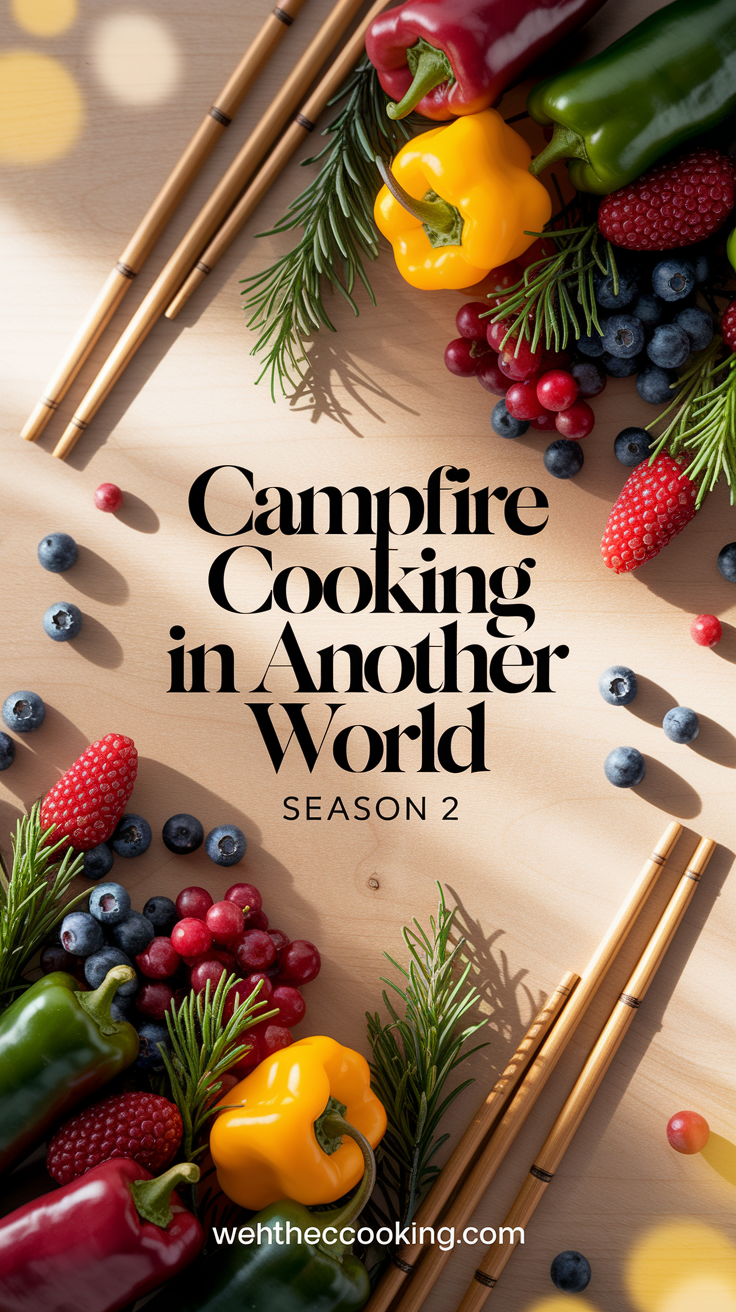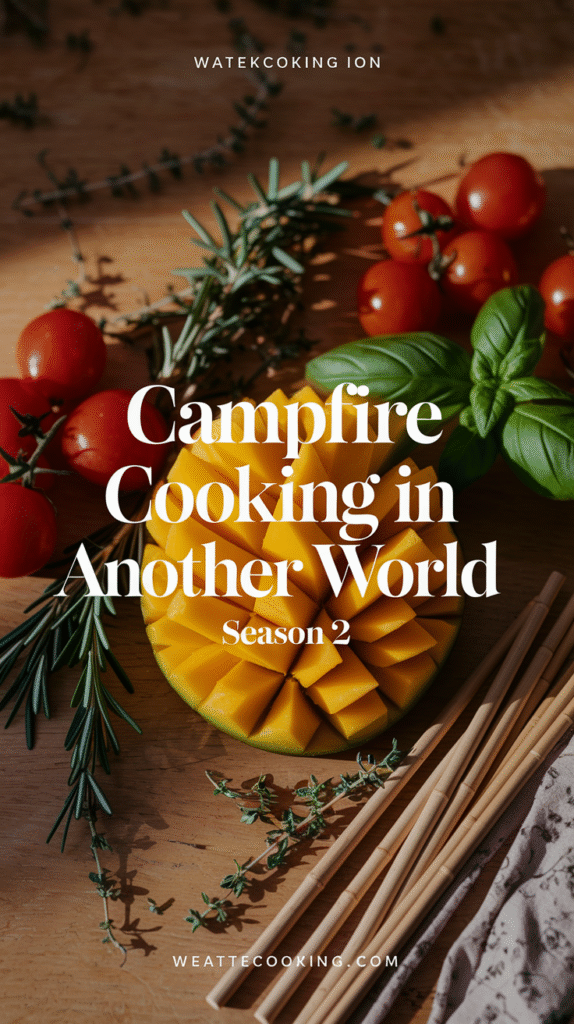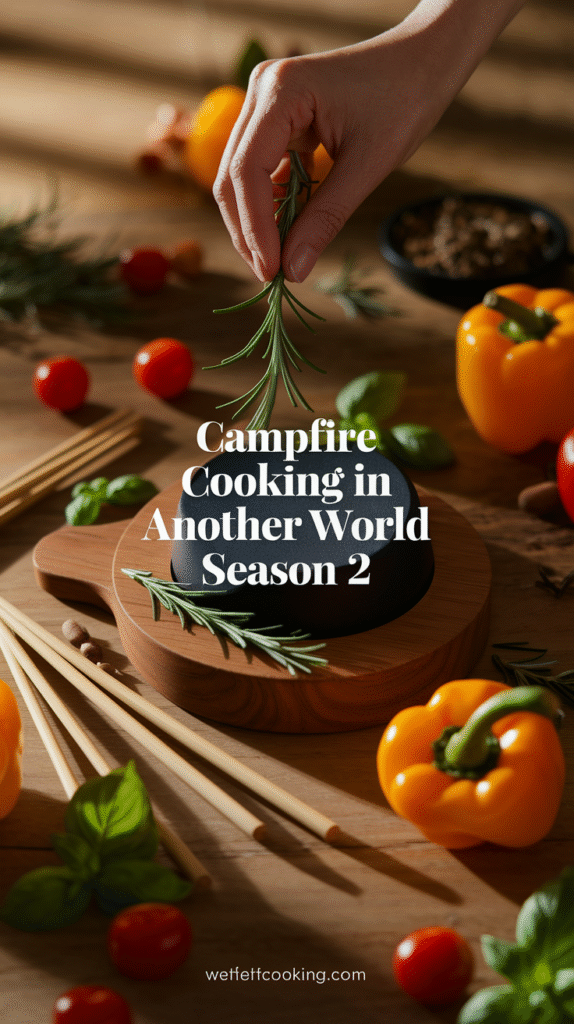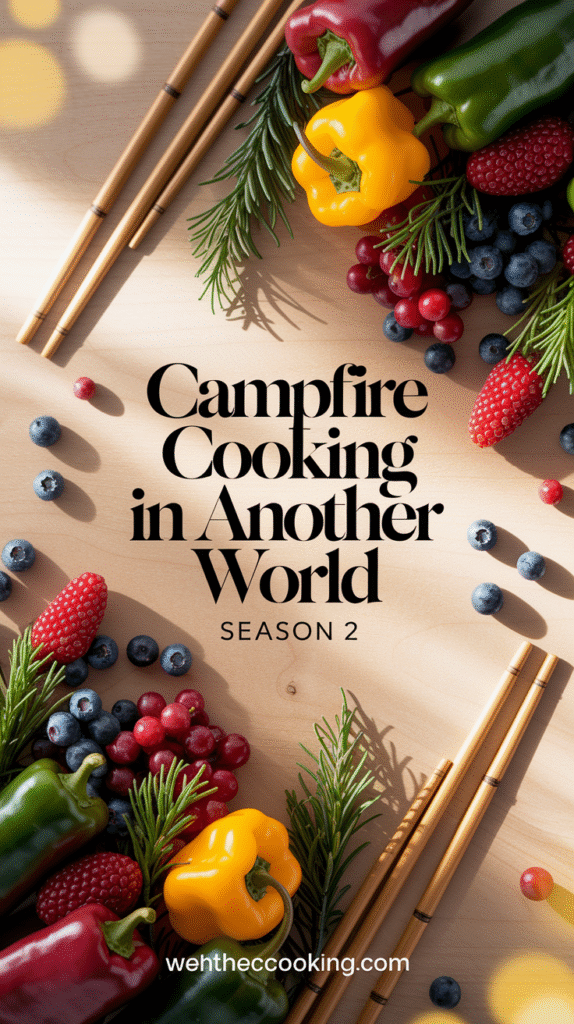The second season of the popular series has introduced more culinary adventures that take viewers on a delightful journey through the art of campfire cooking. With its unique blend of fantasy and gastronomy, this season promises to engage the audience and inspire both fans of the show and cooking enthusiasts alike. Each episode is packed with mouthwatering dishes and novel cooking techniques that add a layer of excitement to the narrative.
In this season, the protagonist continues to explore the mystical realm while discovering new ingredients sourced from the enchanting lands. These ingredients enhance the cooking experience, providing not only visual delight but also flavor depth that captivates the senses. Here’s a look at some of the highlights from the season:
Unique Ingredients to Discover
- Fairy Dust Spice: A shimmering powder that can be added to any dish for an extra kick and a hint of sweetness.
- Dragonfruit: A rare fruit that is not only visually stunning but also boasts unique flavors that elevate any meal.
- Moonlit Mushrooms: Bioluminescent fungi that provide a magical glow, perfect for evening meals.
- Elemental Herbs: Each herb is tied to a specific element like fire or water, affecting both the taste and the cooking technique used.
New Cooking Techniques to Master
This season showcases various campfire cooking techniques that can be adapted for anyone wanting to enhance their outdoor cooking skills. The protagonists demonstrate methods like:
- Stone Cooking: Utilizing hot stones to cook food evenly, a technique rooted in ancient traditions.
- Wrapping & Roasting: Using leaves from the enchanted trees to wrap ingredients before roasting, adding a unique flavor.
- Skewer Technique: Crafting skewers from branches that are not only safe but also add a natural aroma to grilled foods.
Signature Dishes This Season
Throughout the season, viewers will be treated to an array of signature dishes that emphasize the art and flair of campfire cooking. Some of these mouthwatering creations include:
| Dish Name | Main Ingredients | Description |
|---|---|---|
| Enchanted Stew | Dragonfruit, Moonlit Mushrooms, Elemental Herbs | A vibrant and hearty stew with a rich flavor profile. |
| Fairy Dust Grilled Vegetables | Seasonal veggies, Fairy Dust Spice | Colorful vegetables grilled to perfection with a magical spice. |
| Fire’s Embrace Fish | Fresh fish, Garlic, and Elemental Herbs | A dish infused with fragrant herbs that highlight the fish’s natural flavors. |
Cooking Challenges and Friendships
As the characters delve deeper into their culinary journeys, they face several challenges that test their skills and teamwork. The friendships forged over the campfire resonate throughout the episodes, creating a bonding experience for both the characters and viewers. These moments of camaraderie not only enhance the narrative but inspire viewers to appreciate the shared experience of cooking.
The culinary adventures in this season also encourage viewers to engage with their surroundings and connect with nature through cooking. The picturesque settings serve as a backdrop for learning and creativity, proving that the essence of cooking is more than just the food but also the experience that comes with it.
To further enhance your interest in campfire cooking, consider visiting websites dedicated to outdoor cooking. One fantastic resource is Camp Chef, which offers an array of cooking equipment and techniques that align perfectly with the campfire cooking theme showcased in the show. Another great site is REI, which provides tips and ideas for outdoor culinary adventures.
As the season progresses, fans of the show can look forward to more culinary surprises and innovative recipes that reflect the vibrant world they have come to love. Each episode not only captivates but ignites a passion for cooking and creativity that viewers can bring into their own lives.
Key Ingredients and Recipes from Campfire Cooking
When it comes to campfire cooking, the right ingredients can elevate your outdoor cooking experience. Whether you are in another world or simply enjoying a weekend in nature, having the essentials ensures that your meals are not only delicious but also memorable. Here are some key ingredients that you will want to consider for your next campfire cooking adventure.
Essential Ingredients for Campfire Cooking
- Proteins: Choose from meats like chicken, beef, or fish. Plant-based options like tofu and tempeh work great too.
- Vegetables: Bell peppers, zucchini, onions, and corn are perfect for grilling. You can also pack hardy greens like kale or spinach.
- Seasonings: Bring salt, pepper, garlic powder, and your favorite herbs. Marinades can enhance flavors drastically.
- Fats: Olive oil or butter can help with cooking and add richness to your dishes.
- Grains and Carbs: Items like rice, pasta, or even bread can round out your meal.
- Snacks and Sweets: Don’t forget s’mores ingredients – graham crackers, chocolate, and marshmallows! A sweet treat can end the day on a high note.
Simple and Tasty Recipes
With the right ingredients, the possibilities are endless. Here are a few simple recipes to get you started:
Campfire Foil Packs
This is a versatile recipe where you can customize based on your favorite ingredients.
- Ingredients: 1 cup of protein (chicken, beef, or tofu), 1 cup of mixed vegetables, 2 tablespoons of olive oil, and your choice of seasoning.
Instructions:
- Begin by cutting your protein and vegetables into bite-sized pieces.
- Lay out a large piece of aluminum foil and place the protein and vegetables in the center.
- Drizzle with olive oil and sprinkle your seasonings on top.
- Fold the foil into a packet, ensuring it’s tightly sealed.
- Cook on hot coals for about 20-25 minutes, flipping halfway through.
Campfire Quesadillas
Quesadillas are simple and delicious, perfect for a quick meal around the fire.
- Ingredients: Tortillas, shredded cheese, black beans, and any veggies you like.
Instructions:
- Place one tortilla on a cast-iron skillet or directly on the grill grate.
- Add cheese, black beans, and chopped veggies on half of the tortilla.
- Fold the tortilla over and cook until the cheese melts and the tortilla is crispy, flipping halfway through.
Campfire Banana Boats
For a fun and indulgent dessert, you can’t go wrong with banana boats.
- Ingredients: Bananas, chocolate chips, and mini marshmallows.
Instructions:
- Slice the banana lengthwise, being careful not to cut all the way through.
- Stuff the slit with chocolate chips and mini marshmallows.
- Wrap in foil and place over the campfire for about 10 minutes.
- Enjoy while warm and gooey!
Tips for Flavor and Safety
To make your campfire meals even better, remember these tips:
- Marinate your proteins ahead of time for deeper flavors.
- Use fresh, local ingredients whenever possible.
- Always ensure you have proper fire safety and cooking equipment, like a grill grate or a sturdy pot.
With these essential ingredients and recipes, you’re set to conquer campfire cooking. You’ll be amazed at how easy and satisfying it is to whip up delicious meals under the stars. For more recipes and tips on campfire cooking, you can check out CampCook and RecipeTip.
Now that you have all the tools, head out into the wild and enjoy the warm, smoky flavors that can only come from campfire cooking!
Character Development Through Food in the Series
In many stories, food isn’t just a means of survival; it can also serve as a vital narrative device that deepens character development. In particular, one show that has successfully integrated this concept is “Campfire Cooking in Another World.” Through the diverse culinary experiences shared by its characters, we see their growth and transformation unfold in vibrant ways, particularly in the second season.
The portrayal of food in this series goes beyond mere sustenance. Each dish prepared holds significance, reflecting the characters’ personalities, emotional states, and relationships with one another. As the characters navigate their challenges in a fantastical world, their cooking serves as a canvas for self-exploration and discovery. Let’s explore how the act of cooking and the types of food featured can provide deeper insights into character development.
Building Relationships Through Shared Meals
One of the most apparent ways food fosters character development is through shared meals. The act of cooking and sharing at the campfire creates bonds among the characters. For instance:
- Strengthening Alliances: When characters collaborate to prepare a meal, it symbolizes trust and unity. This cooperation allows them to confront their differences and build stronger partnerships.
- Conflict Resolution: During meal preparations, characters often engage in dialogue that reveals underlying tensions. These moments can lead to resolutions, as they open avenues for communication.
- Character Growth: The cooking process challenges characters to step out of their comfort zones, trying new ingredients or techniques. This development often parallels their personal growth throughout the season.
Cultural and Seasonal Influences on Cuisine
The influence of local culture and seasons further enriches character depth. In the second season, the introduction of new seasonal ingredients presents opportunities for characters to adapt. For example:
| Season | Ingredients | Character Reflection |
|---|---|---|
| Spring | Fresh herbs and greens | Renewal and hope symbolize the characters’ growth as they embark on new journeys. |
| Summer | Fruits and vegetables | The abundance encourages a festive spirit, showcasing the characters’ camaraderie. |
| Autumn | Root vegetables and grains | Preparation for challenges ahead reflects maturity and resilience. |
This incorporation of seasonal food concepts allows viewers to connect their own experiences with nature and the cycles of life. We see characters not only embrace the new flavors but also grow as they face seasonal challenges together.
Emotional Connections Through Cooking
Every dish tells a story. As characters prepare food, they often reminisce about their pasts or express their current feelings. For example:
- Memory and Nostalgia: A character might recreate a dish that reminds them of their family, revealing vulnerabilities and backstory.
- Expression of Care: Preparing a meal for another character often highlights the affection or friendship shared between them. It emphasizes how cooking can be an act of love and concern.
- Facing Fears: Characters may encounter a taste or ingredient they fear, leading to personal breakthroughs as they confront and overcome their anxieties.
The Role of Food in Personal Reflection
Food is not just about consumption; it can ignite introspection. In “Campfire Cooking in Another World Season 2,” characters use cooking as a means of self-discovery:
- Exploration of Identity: Trying out different cuisines allows characters to explore new aspects of their personalities.
- Understanding Roles: The dishes they choose or the cooking methods they embrace often represent their roles within the group.
- Growth Through Failure: When a dish does not turn out as expected, it can lead to pivotal turning points in character arcs, revealing their resilience and determination.
The intricate relationship between food and character development in “Campfire Cooking in Another World Season 2” offers viewers rich layers of meaning. By observing these culinary moments, fans gain deeper insights into the characters’ emotions, desires, and growth. Not only does it enrich the narrative, but it also creates a sense of warmth and connection that resonates with the audience.
For more insights into character development through food in various series, you might explore relevant cooking blogs or resources that discuss the intersection between culinary arts and storytelling.
Cultural Influences on Camp Cooking Techniques
Cooking around a campfire is an age-old tradition that varies greatly across different cultures. The influences of geography, available resources, and cultural practices shape the way foods are prepared outside. Understanding these cultural influences adds a rich layer to the experience of camp cooking, enabling campers to explore diverse cooking techniques and flavors.
Regional Techniques and Ingredients
One of the most prominent factors affecting camp cooking methods is geography. Different regions boast unique ingredients, which in turn influences cooking techniques. Here are a few notable examples:
- North America: Traditional Native American cooking often includes methods such as baking in the ground. This technique uses hot stones and earth to slow-cook food, such as root vegetables and meats.
- Asia: In parts of Asia, bamboo cooking techniques are common. Cooking rice or meats within bamboo tubes over the fire infuses food with a subtle flavor while keeping it moist.
- Africa: Many African cultures utilize potjiekos, a dish cooked in a cast-iron pot over an open flame. This slow-cooking method allows for a blend of spices and local meats, resulting in a hearty meal.
- Europe: Cooking with skewers, also known as kebabs, is popular across Europe. This method allows for easy preparation and cooking over an open flame, particularly in Mediterranean countries.
Influence of Cultural Traditions
Cultural beliefs and values also play a critical role in camp cooking techniques. Some communities have built cooking practices around religious beliefs or seasonal traditions. For instance:
- Harvest Festivals: In many cultures, seasonal harvests dictate the types of food cooked at campsites. Celebratory meals are often prepared using freshly harvested ingredients, highlighting the bounty of the season.
- Religious Practices: Certain cultures prepare specific dishes during religious events. For example, Jewish campers may cook challah bread or matzah ball soup to commemorate holidays, even in outdoor settings.
Cooking Equipment and Techniques
The tools and equipment used for camp cooking are influenced by cultural heritage. Different cultures have developed unique cooking apparatus that can impact the preparation and flavor of meals:
- Woks: Common in Asian cultures, woks are versatile tools for stir-frying and steaming food over an open flame.
- Wooden Skewers: Used in various cultures, these skewers allow for grilling meats and vegetables while adding an earthy flavor.
- Portable Clay Ovens: In some Mediterranean regions, portable clay ovens are used to bake bread and pizzas, adding a distinct flavor that resonates with traditional cooking methods.
Health and Nutrition Considerations
Cultural influences on camp cooking extend beyond techniques and flavors; they also encompass health and nutrition. Different cultures emphasize various food groups and preparation methods that can impact a camp meal’s nutritional value:
- Whole Grains: Many indigenous cultures prioritize whole grains like quinoa and corn, which offer higher nutritional value compared to refined grains.
- Lean Proteins: Some cultures focus on utilizing lean proteins, such as fish or poultry, which are often grilled rather than fried, promoting healthier cooking methods.
Creating a Fusion of Techniques
For campers looking to enhance their outdoor cooking experience, combining different cultural techniques can result in a unique culinary adventure. Here’s a simple way to create your own cultural fusion meal:
| Cultural Influence | Technique | Primary Ingredient |
|---|---|---|
| Mexican | Grilling with a comal | Tortillas |
| Middle Eastern | Skewering | Lamb or Chicken |
| Italian | Baking | Pizza |
By adopting various cultural techniques, you can create fulfilling meals while camping, catering to both taste and nutrition.
Whether you’re preparing a Native American stew or Brazilian skewers, understanding the cultural influences of camp cooking adds depth to your outdoor experiences. For more resources on outdoor cooking techniques and recipes from different cultures, consider visiting Camp Cooking or Outdoor Life.
Engaging with these diverse culinary traditions not only enhances your camp meals but can also foster a deeper appreciation for the world’s cultures and their connection to food.
Fan Theories and Speculations for Future Episodes
As fans eagerly anticipate more adventures from the animated series, the theories surrounding future episodes have begun to bubble up like a well-stirred pot over a campfire. With its unique blend of cooking magic and fantasy, “Campfire Cooking in Another World” has given viewers plenty of fodder for speculation. Fans have been quick to piece together clues from every episode, creating fascinating theories about where the story might venture next.
One of the most discussed theories involves the potential for new culinary challenges. As the protagonist, Tsutomu, familiarizes himself with the various regions of this enchanted world, fans speculate he will encounter new ingredients and magical dishes that require creativity and knowledge. Imagine a storyline where each episode he competes in cooking contests against local chefs to retrieve a rare ingredient or gain favor with a powerful ally.
Let’s look at some specific fan theories that have gained traction:
- **The Emergence of Rival Chefs**: Many fans believe that rival chefs from different factions will appear, adding a layer of competition. These chefs could wield unique cooking techniques, making it necessary for Tsutomu to adapt and evolve his skills.
- **Magical Ingredients with Special Powers**: Viewers speculate on the potential introduction of a cooking ingredient that grants a temporary power boost or enchanted abilities to those who consume the dish created from it. This could lead to unique plot twists in critical battles.
- **New Villains with Culinary Curses**: Some fans suggest that future episodes may introduce villains who use cursed food items to create mischief. Tsutomu would need to use his skills to reverse these curses through inventive recipes.
Building on the idea of competition, another thrilling notion is that Tsutomu’s cooking skills will be tested against not only locals but also against the backdrop of a grand culinary tournament. Such an event could draw participants from various territories, showcasing their techniques and magical cooking styles, thus allowing for exciting character interactions and world-building.
Additionally, there is a sense that Tsutomu’s abilities go beyond simple cooking. Fans theorize that he might eventually unlock deeper connections with the magical aspects of food preparation, perhaps leading to a storyline where he can commune with food spirits or even animate prepared dishes into sentient helpers in future episodes.
Another compelling idea revolves around the evolution of Tsutomu’s sidekick, the adorable yet mischievous beast, who may undergo character development throughout the series. Viewers speculate that this sidekick could reveal its own special cooking talents and possibly become Tsutomu’s kitchen assistant, enhancing the comedic elements and deepening their bond.
| Theory | Details |
|---|---|
| Rival Chefs | Introduction of competitive chefs to challenge Tsutomu’s skills. |
| Magical Ingredients | Introducing rare ingredients that grant special powers. |
| Culinary Curses | Villains who use cursed foods to create challenges for Tsutomu. |
| Culinary Tournament | A grand event where chefs showcase their skills. |
| Food Spirits | Taking cooking to a mystical level with spiritual interactions. |
| Sidekick Development | Enhanced cooking skills of the sidekick character. |
As the series progresses, fans are also looking forward to deeper lore exploration and world-building. The fantasy universe certainly offers endless possibilities, and each dish created by Tsutomu seems to reveal more about the culture, traditions, and conflicts of different regions. Fans speculate that additional backstories for secondary characters, along with their culinary philosophies, will also become central to the narrative.
For avid fans and newcomers alike, keeping an eye on forums and blogs has proven fruitful. Various communities have been active in discussing “Campfire Cooking in Another World Season 2” and its potential directions. Websites like Anime News Network and Crunchyroll are fantastic resources for staying updated on episodes, fan theories, and news about the anime adaptions.
Ultimately, the delicious blend of adventure and food has created a rich canvas for speculation. Whether you are invested in the potential of culinary rivals or enchanted ingredients, one thing is for sure—viewers are excited to see where Tsutomu’s journey takes him next, and the theories just keep getting more creative.
Conclusion
As Season 2 of “Campfire Cooking in Another World” continues to unfold, the culinary adventures are not just about the food but the deeper connections forged between characters and their surroundings. The incorporation of unique ingredients and captivating recipes brings the series alive, allowing viewers to engage more intimately with each episode. Each dish crafted by our protagonists serves as a window into their growth, transforming mere survival into a delightful exploration of flavors and techniques.
The series beautifully intertwines cultural influences, showcasing how different elements from various backgrounds inspire camp cooking techniques. This not only adds authenticity to the storyline but also enriches the viewers’ understanding of diverse culinary traditions. As fans eagerly consume each episode, they can’t help but discuss character development driven by food and how these moments reflect broader themes of trust, cooperation, and personal growth.
Speculation runs wild among fans, with many discussing potential storylines and hidden meanings. The excitement surrounding what ingredients, recipes, or culinary challenges the characters might face next keeps the fandom actively buzzing. As viewers anticipate the next adventure, the blend of cooking, culture, and character exploration promises to deepen the series’ allure.
“Campfire Cooking in Another World Season 2” is more than just a show about food; it is a heartfelt journey of growth, friendship, and the magic that occurs when people come together around a fire. Whether you’re a seasoned fan or new to the series, this season is sure to satisfy your hunger for both culinary creativity and rich storytelling.







Leave a Reply